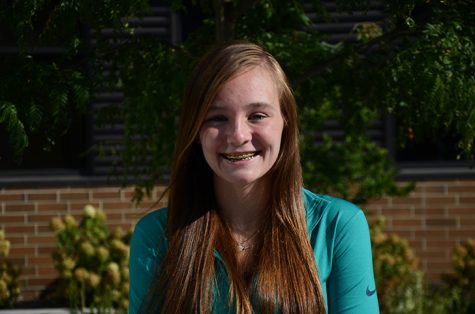I Have A (New) Plan
The road to a new Advisory
Kara Gootee in Mrs. Phillip’s Advisory. Gootee, along with the other seniors, is writing an email with advice for next year’s sophomore class.
May 23, 2018
Since starting school in the new building, students were promised a new and improved advisory curriculum with more beneficial activities and lessons suited to each grade’s needs. The purpose of advisory was to build relationships in a single classroom over the course of the students’ high school experience while meeting the specific needs of each grade level in order to graduate. Advisory was introduced to us as a way to ensure that each grade level has a specific goal in preparing for graduation, and that our advisors were given the tools and instructions to help us meet those goals. However, many students felt that advisory is often more troublesome than it is helpful, and the class was only used to eat snacks, which doesn’t exactly prepare us to be responsible adults. As a result, we were promised that advisory would become the helpful and informational class that it was intended to be.
With the start of the new year, the counseling office took over the planning of Advisory. The reasoning behind the switch of command was to give the counselors more influence on our preparation for graduation in an attempt to turn us into fully-functioning adults that know how to write resumes and apply for student loans. Counselor Susan Baker said, “Last year we had a meeting with Principal Ryan Woods and he felt that with the new building and such, we needed to have more of an emphasis on the Advisory in terms of making it more consistent.”
Since the switch, we have started using the website Family Connections, which feels eerily similar to the I Have a Plan program that we started in middle school, and were told that we would use and complete in high school before we would be allowed to graduate. Personally, I don’t think I made it past step four in the program before the teachers seemed realize that the students were losing interest.
Advisors began half-heartedly insisting that we complete the required steps, or else we would be so far behind when we got to high school we would not be even close to prepared for the next steps in the program, much less graduation and the “real world”. Since getting to the high school, I am both relieved to hear that I am no longer required to endure the tedious trials and tribulations of I Have a Plan, but cannot help wondering if Family Connections is any better. It seems as though Family Connections is the repeat of a program that failed to deliver the intended results, making many students dismiss the new program altogether. Baker said the district purchased Family Connections a couple of years ago through Naviance and decided to make use of it. “Part of that is to help counselors see where students are applying to school but also more importantly to give students resources,” Baker said.
However, with the counseling office directing advisory, there has been more of an effort to accomplish something in class. The most noticeable difference from last year, other than switching to Family Connections, seems to be stress on the important of mental health. Advisory classes spent two or three Thursdays over the course of the year going over how to get help for ourselves and others, the hope for students feel included and happy at school, and how to treat others without judging them. Emily Phillips, a senior Advisory instructor, thinks that this is a step in the right direction. “This year, counseling has taken over and we’ve done a lot more impactful learning, especially for seniors – which are who I have in my class–and focusing on mental health, which I think is really important right now.” Phillips said.
Phillips explained that before the counselors took over, Advisory seemed to be lacking direction. Staff were instructed to give announcements.
Phillips wishes for Advisory to focus on student relationships, suggesting that each teacher could have a group that has an interest in the teacher’s department, or similar interests as the teacher for a better fit. “For me, students who are going into the arts would be better for me to advise than students who are going into business or something like that.” Phillips said.
While that may be difficult for those who are undecided on their future plans, I definitely agree that a focus on building solid relationships with students is vital to the success of Advisory.
As a whole, Advisory has not changed as much as I had expected since last year, but it may not be a lost cause. I still have no idea how to be an adult, but I am getting faster at those career aptitude tests that we had to complete for I Have A Plan and Family Connections. However, the small changes that I have seen give me hope that a better Advisory may be more organized and helpful in the not-so-distant future. Phillips agreed, “I still feel like we have a long way to go with Advisory, but I feel like we have a really good start. I like the direction that they’re taking it but I still feel like it needs to be a little more organized, directed, more informed for staff so we know exactly what the purpose is and what we’re supposed to be doing.” In short, the road to reforming Advisory may be longer than we thought, but at least we have a start.





